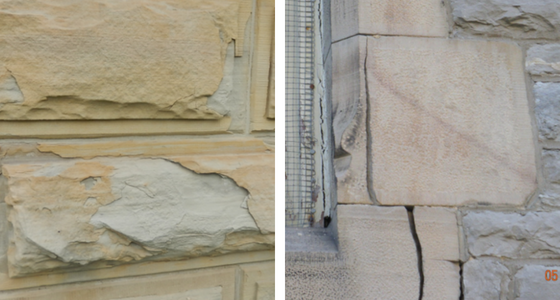Many older, natural stone structures have deteriorated surfaces, some of which cause aesthetic, life-safety, or structural concerns for their owners. Unlike brick or other façade materials, natural stone, particularly sandstone, tends to deteriorate. Due to this unique characteristic, the repair, restoration, and preservation of this material requires a thorough understanding and comprehensive evaluation.
Source of Deterioration
The first step in designing a repair project is to consider the source of the deterioration. Often, it is due to weather, climate, or environmental conditions. Deterioration may also be due to the forces of man, such as poor flashing design, improper construction, over-loading, or improper previous repairs.
The following are common sources of stone deterioration:
– Natural weathering
– Deterioration of joint material
– Lack of maintenance
– Improper previous repairs
– Poor copings and flashing details
– De-icing salts
– Improper coatings
– Location on the building
– Climate and weather, freeze-thaw damage
Types of Deterioration
The source of the deterioration is often responsible for the type of deterioration which the stone exhibits. Below is a short list of the common types of stone deterioration:
– Staining, biological growth, efflorescence, and sub florescence
– Cracking
– Spalling
– Delamination
– Exfoliation and scaling
– Disintegration and erosion, loss of naturally binding minerals
Repair Methods
Unit replacement is often the best way to achieve the closest match to the original appearance (assuming the original quarry can be located). Unfortunately, unit replacement is typically not feasible, either due to cost, logistics, or due to the construction of the building. For example, stones near the sidewalk that are deteriorated from de-icing salts may be 24 inches deep and carry the load of a multi-story building. When the cost of replacement outweighs the financial benefit, we must turn to restoration methods such as:
– Dutchman
– Custom patching
– Mechanical stitching
– Re-dressing
– Consolidation treatments and other coatings
Since the forces of man and nature affect each structure in different ways, the project team should install in-situ mockups to establish expectations for any repair program. It is important to understand that it can be difficult to make a permanent repair that will restore the original appearance of the building. For more information or for a detailed assessment of your situation, please contact Trisco Systems, Inc. at 419-339-3906.


